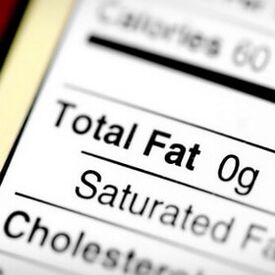A low-carbohydrate diet; without fat; chili and cabbage soup; strictly yellow dragee and water. It seems like every day there's a new weight loss diet plan that promises quick results, from smart to crazy. Eating right to lose weight is something that many of us have tried to do at least once. . . or twice. . . or, let's face it, many times.

Important moments for proper nutrition
Your cousin swears that giving up bread for a few weeks helped her shed the pounds right before college. On the other hand, you might not have eaten a piece of bread for five years and still not lost those last few pounds. As soon as you learn the subtleties of one diet, another appears, threatening to be even more effective.
Take, for example, a study conducted in August 2015. It found that for obese adults, cutting back on fatty foods helped them lose weight 68% faster than cutting back on carbohydrates. What great news!
But before you start ditching your favorite full-fat dairy products, check out another study from just two months later. According to this study, following a low-carb diet, as well as a Mediterranean diet, is more effective in weight loss than restricting carbohydrate intake. Scientists say that no diet works well in the long term, and a low-fat diet for weight loss can even be harmful.
However, hope dies last. In fact, there is an optimal diet plan that will help you lose weight. This is the meal plan that works for you. Not in the case of your husband, brother or colleague, but one that works with your body's needs and, combined with regular exercise, makes you feel great.
So what is the right diet for weight loss? A meal plan should not be seen as something to be followed for weeks or months until you reach your target weight, after which you can go back to your old habits. In fact, going back to old eating habits is why researchers say diets don't work.
Instead, a healthy eating plan should be a lifestyle change that you can stick to because, unlike restrictive diets or fancy fads, it's something that's sustainable. The way you eat should make you feel better, providing your body with the nutrients it needs to live a long, happy and healthy life.
How to eat right to lose weight
Below is information on the best healthy eating plans for weight loss that can help you make the most informed decision.
low carb diet

By following a low-carb or ketogenic diet (an extremely low-carb diet), you drastically reduce or eliminate your glucose intake. Once your body runs out of glucose and there are few or no carbohydrates in your diet that your body uses for energy, your body will begin to use stored fat for this purpose, helping you lose weight quickly.
Advantages:
- You will likely experience rapid weight loss, especially in the first few weeks and months. When we eat foods with sugar and carbohydrates, our bodies release insulin, a hormone responsible for storing energy and body fat. It sends a signal to your cells to store as much energy as possible in the form of glycogen. By drastically reducing our carbohydrate intake, our bodies produce less insulin. Less insulin in our blood means that glycogen is used by our bodies for energy and not stored, and when it runs out fat is used.
- You can reduce your risk of developing diabetes. When you switch to a low-carb diet, you naturally consume much less sugar and starch. Conversely, a high-carbohydrate diet can increase the risk of diabetes, cardiovascular disease, and obesity.
- Since you'll ideally be replacing grains and other carbohydrates with foods rich in protein and healthy fats, you'll feel fuller and less hungry. Fat and protein are known for their satiety effect, while cutting back on carbs helps turn off ghrelin, the "hunger hormone. "
disadvantages:
- Reducing or completely eliminating carbohydrates from the diet can lead to a lack of energy and a feeling of fatigue. If you are particularly active (e. g. playing sports), a low-carb diet can reduce your endurance, which is so necessary during exercise.
- Carbohydrates are hiding in unexpected places like fruits, legumes and quinoa. Completely removing them from your diet can negatively affect your intake of essential vitamins and minerals.
A low-fat diet

Eating for weight loss in the form of a low-fat diet reduces the amount of fat consumed, both from plant and animal sources. This diet became especially popular in the United States after the publication of the federal government's Dietary Guidelines in 1980, which led to the introduction of low-fat foods.
Advantages:
- Foods high in fat are also usually high in calories. If you're on a calorie-restricted diet, cutting back on high-calorie foods will likely help you lose weight.
- Limiting your intake of unhealthy fats (such as trans fats) found in sweets, fast food, processed foods, and other processed foods can help you lose weight; plus it will heal your body.
disadvantages:
- Low-fat foods are often processed foods containing refined sugar and unnatural ingredients designed to make low-calorie foods look like their naturally fatty counterparts. These added ingredients can actually cause weight gain.
- Giving preference to foods without fat, people often abuse them. This happens for two reasons: low-fat foods simply cannot match the taste and nutritional value of normal foods, and we are more likely to eat more of them because we know they are low in calories.
- Our bodies need fat! Although foods like avocados or butter may be high in calories, they contain healthy fats that our bodies need to function properly. Which would you prefer: butter made from cow's cream or a "butter substance" created in a lab?
Mediterranean diet

The Mediterranean diet originates from Mediterranean countries such as Italy, Spain, Greece, etc. The Mediterranean diet cannot be called a diet per se - it is a regular diet that contains fresh fruits and vegetables, healthy fats such as olive oil, high-quality poultry and seafood, all natural and grown without the use of synthetic fertilizers. , fodder, etc.
Advantages:
- Because this diet focuses on natural foods, you will consume very few processed or sugary foods. You're more likely to snack on nuts than crackers, for example.
- An abundance of foods rich in healthy fats helps reduce the risk of developing cardiovascular disease.
disadvantages:
- Although healthy fats are good for us, we need to control our food intake. Because it's so tasty, it's easy to give in to the urge to eat a little more, which can lead to overeating.
- Although the Mediterranean diet is great for your body in the long run, if you're looking to lose weight fast, it's probably not for you.
Vegetarianism or veganism
Although there are varying degrees of vegetarianism and veganism, most vegetarians avoid eating meat, including seafood and poultry. What do vegans eat? Well, they avoid all animal products, including dairy and eggs.
Advantages:
- A plant-based diet is naturally low in fat and high in fiber. You don't have to count calories when you eat lettuce.
- Vegetarian diets are associated with lower blood pressure and lower cholesterol levels. If you want to control these conditions naturally, eliminating meat can help.
- Good quality meat can be expensive! Eliminating it from your diet can really help you save money in your budget.
disadvantages:
- Avoiding animal products does not guarantee that you will eat healthy, nutritious foods.
- High-quality animal meat provides the body with essential nutrients that are difficult to obtain from plant foods. Vegans especially need to beware of their dietary deficiencies and should consider taking supplements.
paleo diet
What about the paleo diet and veganism? These are the two most fashionable diets. "Go paleo" is something we hear more and more these days, especially in the sports community. A Paleolithic diet consisting of foods that our ancient ancestors ate - natural meat from animals (fed natural food forthem), wild fish, nuts, roots, vegetables and fruits.
Advantages:
- Switching to a grain-free diet can be very beneficial because you are removing the insulin-spiking carbohydrates found in grains and replacing them with more vegetables.
- Following a hunter-gatherer diet can help you get more minerals, omega-3 fatty acids, protein, and healthy fats from your diet. In fact, if you follow the paleo diet correctly, it can help improve autoimmune conditions and help you lose weight naturally.
- Along with eliminating grains, sugar (the main cause of chronic inflammation and disease) is also completely eliminated from the diet. Instead, the diet is full of popular anti-inflammatory foods like wild salmon (or similar fish), blueberries, leafy greens, and nuts.
disadvantages:
- Unfortunately, many who follow the paleo diet often consume too much meat, as well as some of the toxic substances of animal origin.
- In addition, people often consume non-organic foods, including meat, butter, vegetables and fruits. Unless you can afford to buy exclusively organic foods, this diet cannot be considered a paleo diet.
Remember that it is not necessary to follow the rules of a certain diet, drawing up a strict menu for proper nutrition for weight loss. Some aspects of a diet may appeal to you, while others may not.
For example, you might want to go vegan one or two days a week to give your wallet a break and encourage your family to try different seasonal vegetables.
Or you can reduce your carbohydrate intake for a few weeks to even out your insulin levels and then switch to a Mediterranean diet where whole grains are eaten in moderation. This is all very good!
You don't need to eat certain weight loss foods day after day, week after week. It's important to simply eat right, eating mostly organic produce and cutting out all processed foods and sweets whenever possible. After all, "best" diets (diet systems for weight loss) come and go, but organizing a diet based on natural vegetables and fruits, meat and fish, nuts and whole grains never goes out of style.













































